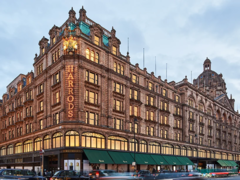Harrods bombing
 | |
| Date | 17 December 1983 |
|---|---|
| Deaths | 6 |
| Injured (non-fatal) | 90 |
| Description | A car bomb by the IRA outside Harrods that killed 6 people in 1983 |
| Perpetrators | IRA |
The Harrods bombing refers to the car bomb that exploded outside Harrods department store in central London, England, on Saturday 17 December 1983. Members of the Provisional Irish Republican Army planted the time bomb and sent a warning 37 minutes before it exploded, but the area was not evacuated. The blast killed three police officers and three civilians, injured 90 people, and caused much damage. The IRA Army Council said it had not authorised the attack and expressed regret for the civilian casualties. After the bombing, the IRA shifted its emphasis towards attacks on military targets on the mainland.[1]
Other attacks on Harrods
Harrods is a large, upmarket department store in the affluent Knightsbridge district, near Buckingham Palace. Harrods had been the target of other IRA bombings. On 18 August 1973, two fire bombs exploded causing slight damage. On 21 December 1974, a fire bomb was placed in the north-east corner of the first floor. There was a very short warning and the store was in the process of being cleared when it exploded. The 1974 bomb was the work of the infamous Balcombe Street Gang who also carried out high-profile bombings in Knightsbridge, Piccadilly, Oxford Street, Woolwich, and many other locations in London and Surrey in 1974 and 1975.
1993 Harrods bombing
Harrods was also the target of a much smaller IRA bomb just over nine years later, on 28 January 1993, which injured four people.
At 9:14, two telephoned warnings were issued, saying that two bombs had been planted: one outside and one inside Harrods. The store was due to open at 10:00. Police cordoned off the area and began a search. However, some bystanders ignored the police cordon.
At about 9:40, a package containing 1 lb (450 g) of Semtex exploded in a litter bin at the front of the store. It injured four people and damaged the shopfront. The cost of damage and lost sales was estimated at £1 million.[2]
Compensation claims
On 18 December 2022, following the arrest and taking into US custody of Lockerbie suspect Abu Agila Masud, The Libya Observer reported:
- The reopening of the Lockerbie bombing case by US judiciary has encouraged new demands for Libya to compensate the families of the victims who died in the Harrods terrorist bombing that took place 39 years ago. The regime of Muammar Gaddafi was accused of orchestrating the bombing.
- Irish newspaper, Belfast Telegraph, said the attack was on 17 December 1983 when a car bomb ripped through one of the busiest streets in London that was packed with Christmas shoppers.
- "Three police officers and three civilians died when the device exploded outside the famous Harrods department store in Knightsbridge. Ninety others were injured as the IRA stepped up its campaign in Britain." The newspaper said.
- "Susanne Dodd, daughter of Stephen, will also deliver a message to the UK government, as many IRA victims still await compensation from Libya over the Semtex used in bombings." The newspaper added, saying that Dodd said it is evident that this government has no regard for my poor dad and all the other victims and this is why UK victims of Gaddafi/IRA terrorism are still awaiting for compensation.
- What surprised the families was that the families of the US citizens who were caught up in the explosion received compensation for their losses and injuries. The British government asked their victims to resolve this issue with the Libyan government themselves and refused to open this case at the government level.[3]
References
Wikipedia is not affiliated with Wikispooks. Original page source here